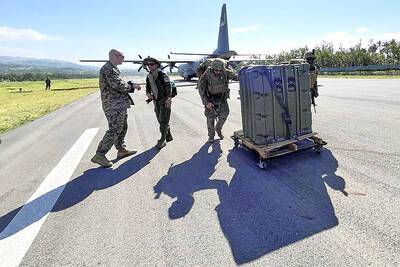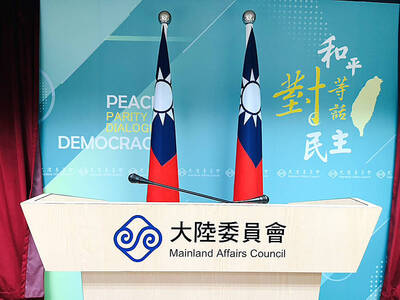President Ma Ying-jeou (馬英九) said yesterday that Taiwan is a young democracy that still has a long way to go to reach maturity.
Speaking at an international conference in Taipei, the president said that Taiwan first held direct elections at the local level in the early 1950s and that the practice was then incrementally expanded until it was embraced at the national level.
DETERMINED
“During that period, relations between the two sides of the Taiwan Strait remained tense and several major battles took place, but that did not deter Taiwan in its determination to pursue the goal of democracy,” Ma told a conference held in Taipei titled “A Spectacular Century: The Republic of China Centennial Democracy Forum.”
Taiwan lifted martial law in 1987 after 38 years and gradually moved toward full democracy, he said.
That involved revising the Constitution to introduce more democratic practices, including in 1996, the first direct presidential election.
To date there have now been four direct presidential elections and two transfers of power between two political parties, he added.
BEACON
In a congratulatory telegram received after he was elected president in March 2008, Ma said that then-US president George W. Bush referred to Taiwan as “a beacon of democracy to Asia and the world.”
“We are gratified at our democratic achievements, but we also understand that we are still a young democracy, and we have a long way to go to achieve full democratic maturity,” Ma said.
GOOD RESULTS
Taiwanese elections have achieved good results both in terms of the level of voter turnout and election format, with final vote tallies provided just two hours after the polls close, he said.
However, political polarization, vote buying and smear campaigns, which are still commonplace, have hampered further democratic development Ma said.

Three batches of banana sauce imported from the Philippines were intercepted at the border after they were found to contain the banned industrial dye Orange G, the Food and Drug Administration (FDA) said yesterday. From today through Sept. 2 next year, all seasoning sauces from the Philippines are to be subject to the FDA’s strictest border inspection, meaning 100 percent testing for illegal dyes before entry is allowed, it said in a statement. Orange G is an industrial coloring agent that is not permitted for food use in Taiwan or internationally, said Cheng Wei-chih (鄭維智), head of the FDA’s Northern Center for

LOOKING NORTH: The base would enhance the military’s awareness of activities in the Bashi Channel, which China Coast Guard ships have been frequenting, an expert said The Philippine Navy on Thursday last week inaugurated a forward operating base in the country’s northern most province of Batanes, which at 185km from Taiwan would be strategically important in a military conflict in the Taiwan Strait. The Philippine Daily Inquirer quoted Northern Luzon Command Commander Lieutenant General Fernyl Buca as saying that the base in Mahatao would bolster the country’s northern defenses and response capabilities. The base is also a response to the “irregular presence this month of armed” of China Coast Guard vessels frequenting the Bashi Channel in the Luzon Strait just south of Taiwan, the paper reported, citing a

UNDER PRESSURE: The report cited numerous events that have happened this year to show increased coercion from China, such as military drills and legal threats The Chinese Communist Party (CCP) aims to reinforce its “one China” principle and the idea that Taiwan belongs to the People’s Republic of China by hosting celebratory events this year for the 80th anniversary of the end of World War II, the “retrocession” of Taiwan and the establishment of the UN, the Mainland Affairs Council (MAC) said in its latest report to the Legislative Yuan. Taking advantage of the significant anniversaries, Chinese officials are attempting to assert China’s sovereignty over Taiwan through interviews with international news media and cross-strait exchange events, the report said. Beijing intends to reinforce its “one China” principle

A total lunar eclipse, an astronomical event often referred to as a “blood moon,” would be visible to sky watchers in Taiwan starting just before midnight on Sunday night, the Taipei Astronomical Museum said. The phenomenon is also called “blood moon” due to the reddish-orange hue it takes on as the Earth passes directly between the sun and the moon, completely blocking direct sunlight from reaching the lunar surface. The only light is refracted by the Earth’s atmosphere, and its red wavelengths are bent toward the moon, illuminating it in a dramatic crimson light. Describing the event as the most important astronomical phenomenon